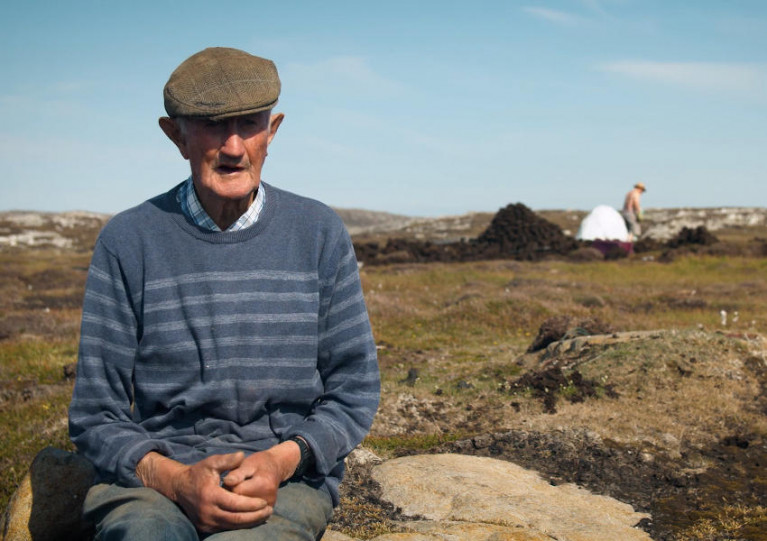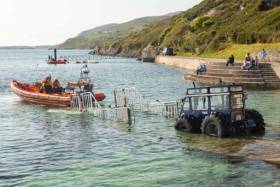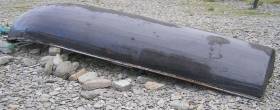Displaying items by tag: Inishbofin
Inishbofin Campaigner Supports Omey Islander Descendant's Call for Remains to Be Returned
A descendant of Omey islanders has demanded that all remains of human burials removed in an emergency excavation from the Connemara island’s graveyard be returned.
As The Sunday Independent reports, Maggie Coohill has said she is “disappointed and disgusted”, and very frustrated at the response to queries she has submitted in relation to the location of up to 60 skeletons taken from Omey graveyard in the early 1990s.
Support for Coohill and the Omey descendants has been voiced by Marie Coyne, who led the campaign to have skulls held at Trinity College, Dublin, returned for burial on Inishbofin.
“The Omey remains must be returned as soon as possible to Omey island, as this was their resting place and must be again,” Ms Coyne told The Sunday Independent.
“By now, some 30 years since they were removed, enough tests must have been done on them, and also remember these people did not donate their bodies to medical science,” Ms Coyne said.
“These people have suffered enough in life and deserve a proper burial; they deserve respect,” she said.
The excavation at Omey Island, led by Prof Tadgh O’Keeffe of University College Dublin, was commissioned in the early 1990s after storm damage, coastal erosion, and rabbit burrowing exposed several graves on the Omey shoreline which were at risk of being washed into the Atlantic.
Ms Coohill and several of her cousins have spent the last nine years campaigning for their return after an appeal by her late father, who was one of the tidal island’s last full-time residents.
Just over a year ago, the State’s chief archaeologist Michael MacDonagh apologised to the Omey, Cleggan and Claddaghduff communities for lack of communication over the past three decades on the issue.
Mr MacDonagh said at a public meeting in the summer 2022 that there was no evidence of material from recent burials having been taken during the excavation. He said that research was continuing on the skeletons dating from the 7th to 15th century.
Ms Coohill said she was not happy with the level of communication since this meeting and objected to the suggestion that the skeletons would be kept in the care of the State rather than being reburied as had been originally promised.
A spokesman for the National Monuments Service said it had been in contact with Ms Coohill and informed her that human archaeological remains excavated from Omey island had been recently transferred from UCD to the National Museum Collections Resource Centre in Swords, Co Dublin, where they were being re-catalogued and analysed.
“Discussions with the National Museum on potential reburial of some of the remains will take place following the completion of necessary full analyses of the remains,” the spokesman said.
Read more in The Sunday Independent here.
Inishbofin Island Water Supply Restrictions Lifted
Inishbofin island’s water supply has been deemed safe to drink after months of restrictions.
Irish Water has confirmed that the “do not consume” notice has been lifted “with immediate effect” on the north Connemara island after consultation with the Health Service Executive (HSE).
Elevated levels of manganese in the treated water supply had led to the restriction for health reasons, to protect the island’s population of 156 people, Irish Water said.
“Irish Water acknowledges and understands the impact this notice had on the community, and we sincerely regret the inconvenience,” Irish Water official Eoin Hughes said.
“Our drinking water compliance and operational experts worked hard to resolve this issue as quickly and as safely as possible,” he said.
All islanders and visitors served by the public water supply can “now resume normal use of the water supply for drinking, food preparation and brushing teeth”, Irish Water said.
It said an Irish Water/HSE water liaison group would “continue to meet and will review ongoing process control, monitoring and testing of the drinking water supply”.
It has issued a customer care helpline, which is “open 24/7” on 1800 278 278.
Inishbofin Islanders Start Petition Seeking Return of Skulls from TCD
Inishbofin residents have begun a petition seeking return of skulls taken by a British anthropologist from the island in 1890.
Anthropologist Alfred Cort Haddon enlisted Irish medical student Andrew Dixon to help him when he removed 13 skulls from the ruins of St Colman’s Monastery on the island.
Haddon informed the Royal Irish Academy that they were part of “a collection of Irish crania”, which he gave to Trinity College, Dublin’s (TCD) anthropological museum.
Inishbofin Heritage Museum director Marie Coyne learned of Haddon’s theft after a TCD-sponsored exhibition displayed photograph albums of Charles R Browne, who managed the university’s anthropological museum and was known as the “Irish head hunter”.
When Coyne initially raised the issue, TCD told RTÉ that it "no longer houses the collection” and “its current location” is “unknown".
However, as Ciarán Walsh of Maynooth University outlines in an article for RTÉ Brainstorm, he emailed Marie Coyne to inform her he had seen the skulls still "ranged out like blue jugs" in display cases in the ‘skull passage’– a storage area behind the theatre building in TCD.
He said they were clearly labelled "Inishbofin: Haddon & Dixon", and the collection included one skull from the Aran Islands and ten from St Finan’s Bay.
Walsh said that this triggered a five-year investigation of Victorian anthropology - the skull-measuring business - in Ireland in partnership with Maynooth University, TCD and the Irish Research Council.
Earlier this month,a TCD delegation told islanders at a meeting in the Inishbofin community centre that it was not empowered to take a decision on reburying the skulls – which had been taken illegally.
“They couldn’t tell us anything. I think they wanted to get the feeling on the ground,” Coyne said.
TCD said relevant state bodies would have to be consulted, and there will be a public consultation.
A petition initiated by Coyne and New York University anthropologist Pegi Vail says no further evidence is needed for the skulls and any material taken illegally to be returned to their community of origin. The petition says TCD is due to make a decision in mid-December on the issue.
Read more on RTÉ Brainstorm here
The petition is here
Inishbofin Island Water Alert Over Manganese Levels
As Inishbofin prepares for a storytelling festival next weekend, residents on the island’s public water supply scheme have been told not to consume water due to elevated manganese levels.
Irish Water says the notice applies to approximately 156 island residents on the public scheme and does not apply to other areas and water schemes in Galway.
It says it is “especially important that mains drinking water is not given to bottle-fed infants”.
Irish Water cautions that this is not a boil water notice, as boiling water will not reduce manganese levels and will not make the water safer to consume.
It says tankered water is being made available on the island, near the pier, to provide an alternative water supply to customers.
“ Customers are reminded to use their own containers when taking water from the tanker and to boil water before consumption as a precautionary measure,” it says.
Irish Water says its drinking water compliance and operational experts are “working with colleagues in Galway County Council to resolve this situation as soon as possible”.
Irish Water operations lead Rónan Daly said the State utility was “ aware of the impact a “Do Not Consume Notice” has on the community”.
He said the company “would like to reassure impacted customers that we are working hard to lift the notice as quickly and as safely as possible”.
“We would ask customers who have concerns to contact our customer care team on 1800 278 278,” Daly said.
The first “ Inishbofin Tidings – Storytelling Festival” takes place from September 9th to 11th.
The family-friendly festival opens on Friday evening next, September 9th, with “Stories Untold”, an exhibition opening and book launch at Inishbofin Community Centre.
It involves stories of items found on the beaches of Inishbofin by Veronika Straberger and Marie Coyne.
Also on Friday, actor John O’Dowd and special guests will host the screening of “Desecration”, a film shot on Inishbofin in the 1980s and involving local talent.
Among the many events for both adults and children throughout the weekend, there is an exhibition at the community centre entitled “Light of Hope through Despair”, a visual diary by Tetiana Vysotska of her journey from Bucha, Ukraine to Creggs, Co Galway.
More information on the programme is here
Carlingford, Achill Island, Inishbofin and Causeway Coast Named Among Ireland’s Best Places to Holiday in 2022
Four coastal locations around the island of Ireland are in the running to be named Ireland’s best place to holiday this year, with the winner to be announced this August Bank Holiday weekend.
Carlingford in Co Louth on the shores of Carlingford Lough joins Achill Island in Co Mayo, Inishbofin in Co Galway and Portrush and the Causeway Coast in Northern Ireland in the list of five finalists for the Irish Times Best Place to Holiday in Ireland 2022 contest.
For more details and to find out the winner, see the Irish Times website HERE.
The volunteer crew of Clifden RNLI were requested by the Irish Coast Guard to assist with the medevac of a casualty from Inishbofin on Good Friday.
Clifden’s Shannon class all-weather lifeboat was launched at 11.30am on Friday (15 April) and the crew made the trip to the island off Connemara in good time.
The weather was quite foggy so the crew stood by to assist the Sligo-based coastguard helicopter Rescue 118 in case conditions and visibility deteriorated.
In this case there were no issues and the casualty was successfully airlifted by Rescue 118 and brought to University Hospital Galway for treatment.
Coxswain Alan Pryce said: “In Clifden RNLI we are always happy to provide support and assistance to our local island communities, a medical evacuation is a time critical event and we will always do what we can to ensure a successful outcome.
“I’d like to thank the crew for their rapid response time and wish the casualty well.”
Clifden RNLI’s crew on this callout were Pryce, Thomas Davis, Daniel Whelan, John Mullen and John Heffernan.
Video Series Brings Vivid Snapshots of Life on Inishbofin in Lockdown
A new video series is providing vivid snapshots of life among a Connemara island community during lockdown.
Filming for Inishbofin in Lockdown was completed last spring — when Inishbofin, off western Connemara, joined the three Aran Islands in agreeing to discourage visitors during the initial pandemic restrictions in Ireland.
Island resident Kieran Concannon of C-Board films worked with the Inishbofin Community Services Programme to develop a film project that would capture a unique record of the island and its people amid a time of great uncertainty.
Galway County Arts Office provided funding for the project, which has resulted in a series of short films that have been posted on YouTube since last week. Watch a sample below:
Community Concerns Over Loss Of Galway & Mayo Islands Doctor
Two islands off Galway and Mayo face the prospect of no local doctor with the pending retirement of a mainland-based GP.
As the Connacht Tribune reports, Dr Ciarán McLoughlin will end his services to the community on Inishbofin and Inishturk next week after retiring from his Clifden practice earlier this year.
But as of a week ago, the HSE had not found a replacement full-time GP, and it continues to advertise for the position.
Two Medevacs For Clifden Lifeboat Since Friday
#RNLI - Clifden RNLI has carried out two medical evacuations from the island of Inishbofin off Connemara since Friday (23 June).
The pagers first sounded at 11.15am on Friday in response to a call for the medevac of an elderly woman in need of hospital treatment.
Clifden's D Class inshore lifeboat and crew were already on the water in Clifden Bay carrying out a scheduled exercise when they were called to transfer to the Atlantic 85, helmed by Joe Acton, that arrived at the island before the Irish Coast Guard helicopter Rescue 118, which was also tasked.
Lifeboat crew member Sinead Pryce assisted the casualty, and the lifeboat and helicopter worked together to ensure a seamless transfer.
The following morning (Saturday 24 June), pagers once again sounded shortly after 7.15am after a woman on Inishbofin had become suddenly unwell.
The all-weather boat Fisherman’s Friend was requested to respond and a crew was assembled including coxswain Alan Pryce, mechanic Robert King, navigator Owen Hayes and crew Brian Ward and Neil Gallery.
The casualty was transferred to the all-weather boat by the crew and island nurse and taken to Cleggan Pier where an ambulance was waiting.
Speaking following the callouts, Clifden RNLI lifeboat operations manager John Brittain said: “It has been a busy summer week for the Clifden lifeboats with three launches taking place involving our different boats in different scenarios.
“I want to thank the crew for responding to their pagers promptly in these cases so that we can continue to carry out this vital service in our local community.”
#Currach - The first of four new community-built currachs launches from Inishbofin this afternoon (Sunday 30 April), as Galway Bay FM reports.
Young people from the Connemara island have been heavily involved in the traditional boat-building project, funded via the Coca-Cola Thank You Fund for voluntary groups.
And they will see the fruit of their hard work take to the water from the Old Pier at 1pm today, coinciding with the final day of this year’s Inishbofin Arts Festival.































































